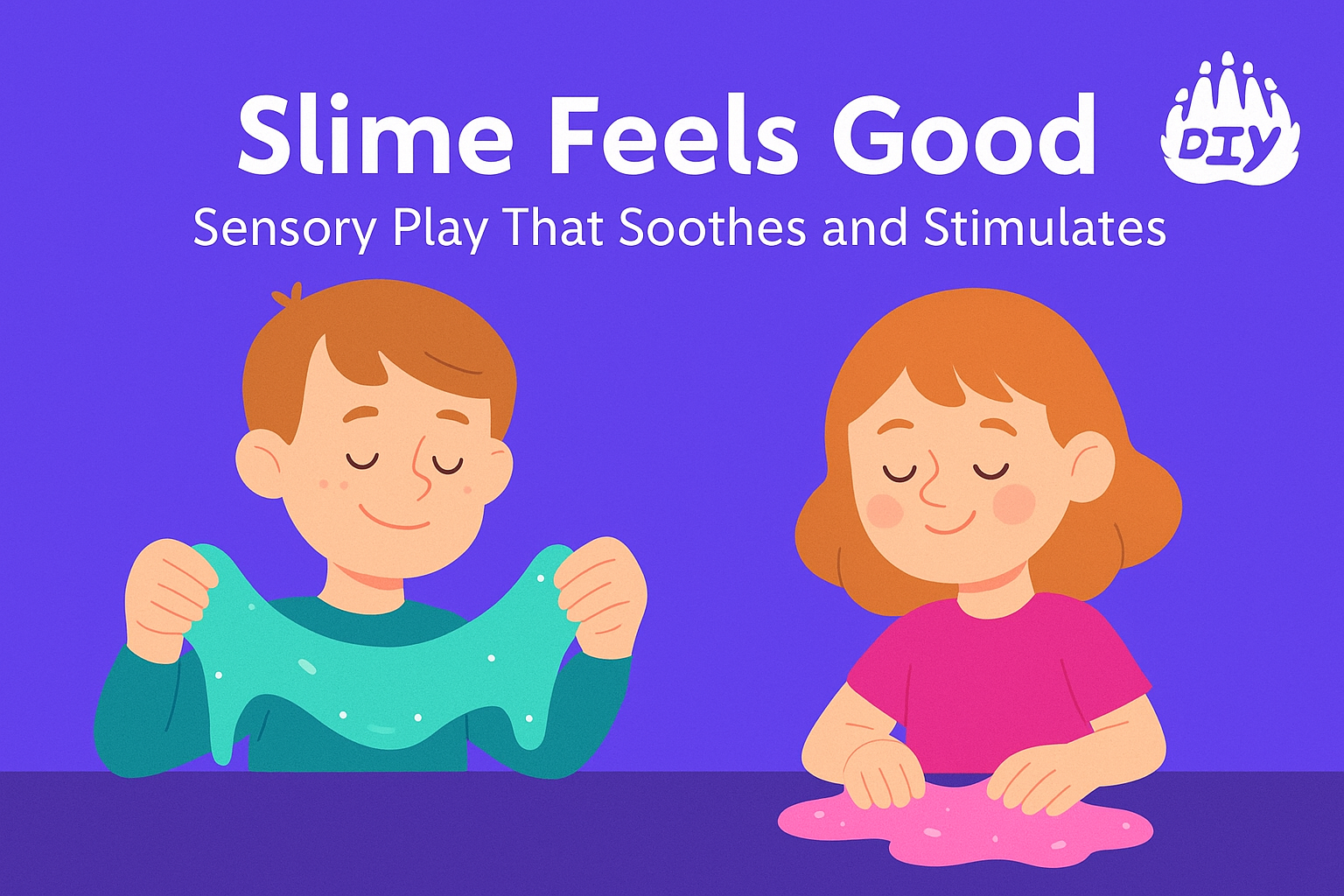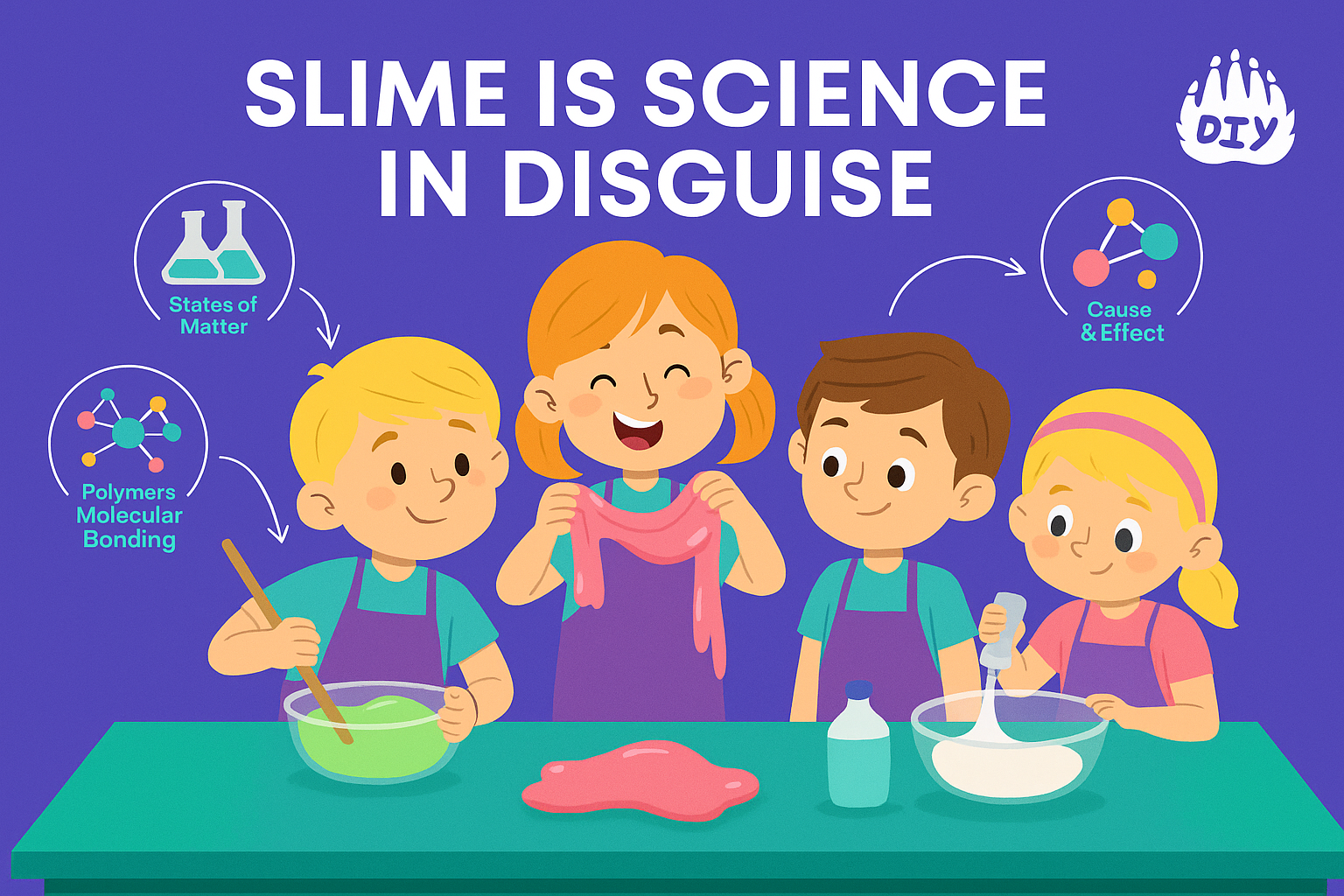Slime has become more than just a playtime trend; it's a powerful mix of sensory play, creativity, and hands-on science. It feels great, it’s fun to make, and it gives kids the freedom to experiment and express themselves. Whether they’re following a classic how to make slime tutorial or trying out recipes for slime without glue or slime without activator, kids are learning through play. At DIY, we view this obsession as a positive force. Slime helps children focus, introduces basic chemistry concepts, and keeps them actively engaged without screens. It’s learning disguised as play.
The 3 Big Reasons Kids Love Slime

1. Slime Feels Good: Sensory Play That Soothes and Stimulates
Slime offers a unique tactile experience. Kids love to stretch, squish, and squeeze it, actions that provide important sensory input. This type of play supports emotional regulation, lowers stress, and improves focus.
For children who are anxious or overstimulated, playing with slime can feel calming. It also provides meaningful feedback for kids who seek tactile stimulation, including many neurodivergent learners. In fact, many parents of children with ADHD or autism report that slime helps their kids feel more centered and attentive.

2. Slime Is Science in Disguise
Every time kids mix glue, baking soda, and saline solution, they’re conducting a hands-on chemistry experiment. Slime is a non-Newtonian fluid; it behaves like both a solid and a liquid offering a gateway into deeper scientific understanding.
Through slime, children naturally explore concepts such as:
Chemical reactions
States of matter
Polymers and molecular bonding
Cause and effect
Kids learn best by doing. With slime, even mistakes become teachable moments. Failed batches are simply experiments that offer new insights.
3. Slime Encourages Creativity and Independence
Slime-making isn’t just about following directions. It’s an open-ended activity that allows kids to personalize their creations. They can experiment with
Colors (using food dye, paint, or natural tints)
Textures (by adding foam beads, glitter, clay, or shaving cream)
Scents (like vanilla, cocoa powder, or essential oils)
Packaging (some even design their own labels and “slime brands”)
This turns a simple recipe into a platform for creativity and innovation. At DIY, we’ve seen kids build entire portfolios based on their slime creations learning practical skills like branding, safe experimentation, video production, and peer feedback.
4. A Screen-Free, Hands-On Activity That Keeps Kids Busy
In a world full of digital distractions, slime stands out as one of the few offline activities that can hold a child’s attention. It’s messy in the best way tactile, sensory, and surprisingly calming. Even younger kids (as early as six) can mix up their own batch using basic household ingredients.
With a little planning, it’s easy to keep the fun under control. Setting up a dedicated “slime zone” and storing creations in airtight containers makes cleanup simpler and keeps the obsession from taking over the whole house.
5. How DIY Turns Slime Play Into Real Learning
At DIY, we believe the best learning happens when kids are having fun. That’s why our Slime Time course is one of the most loved activities on the platform it takes something kids already enjoy and turns it into a playful path for skill-building.
Inside the course, kids can explore
Science basics like polymers and chemical reactions
Creative challenges for making, customizing, and even “branding” their slime
Practical skills that connect to marketing, design, and entrepreneurship
Projects designed for ages 6-14 with safe, guided instructions
It’s more than just a trend. Slime becomes a springboard for creativity, confidence, and problem-solving all while giving kids a chance to experiment, express themselves, and discover new interests.
Slime Isn’t Just a Fad It’s a Tool for Growth
If your child can’t get enough slime, that’s not a bad thing. Beyond the gooey fun, they’re practicing focus, experimenting like young scientists, and learning to take pride in something they created themselves. With the right balance of structure and freedom, a “slime phase” can grow into a passion for science, an outlet for creativity, or even their very first business idea.
Join DIY to turn your child’s slime obsession into something purposeful. From magnetic slime experiments to building their own slime business, they’ll gain practical skills and confidence that will stick with them for life.
Frequently Asked Questions About Slime and Kids
Why are kids obsessed with slime?
Slime is fun, squishy, and calming. It gives kids sensory play, sparks creativity, and keeps them busy without screens.
Is slime good for child development?
Yes. Slime builds focus, fine motor skills, and introduces simple science like chemical reactions and polymers.
Can slime help kids with ADHD or autism?
Many parents say yes. The texture and repetition can calm kids, improve focus, and support sensory needs.
Is slime safe for kids?
Yes, with safe recipes and supervision. Skip borax for young kids use cornstarch, chia seeds, or edible slime instead.
What age is best for slime?
Slime is safe for kids 6+. Younger children can enjoy taste-safe slime, but always with adult supervision.
How does slime teach science?
Making slime shows real science polymers, reactions, and non-Newtonian fluids all through hands-on play.
Can slime be educational and fun?
Absolutely. Kids learn creativity, problem-solving, and even business skills if they make and share slime.
How do you keep slime from making a mess?
Set up a “slime zone,” use airtight containers, and clean as you go. This keeps play fun and manageable.



